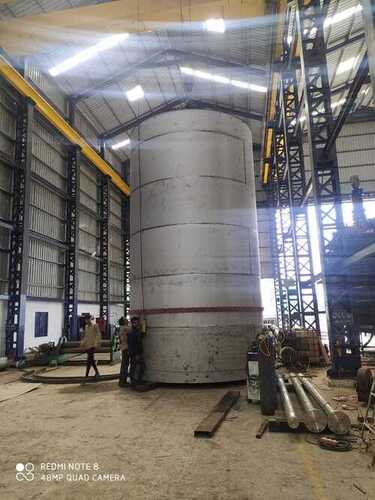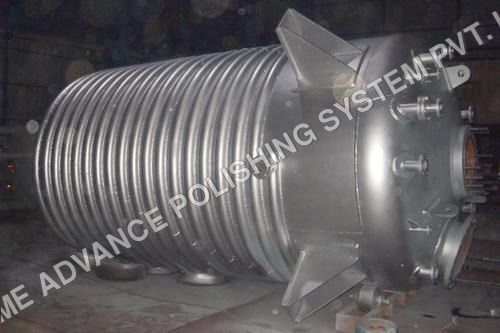Stainless steel Reactor
100000 INR/Unit
Product Details:
- Application Industrial
- Type Reactor
- Usage Industrial
- Material Stainless steel
- Size Customized
- Product Type Stainless steel Reactor
- Condition New
- Click to View more
X
Stainless steel Reactor Price And Quantity
- 100000 INR/Unit
- 1 Unit
Stainless steel Reactor Product Specifications
- Silver
- Industrial
- Stainless steel Reactor
- Customized
- Stainless steel
- Reactor
- New
- Industrial
Stainless steel Reactor Trade Information
- Cash Advance (CA), Cash in Advance (CID), Cheque
- 1000 Unit Per Month
- 1 Week
- Standard Packaging
- Asia, Australia, Central America, North America, South America, Eastern Europe, Western Europe, Middle East, Africa
- All India
Product Description
A stainless steel reactor is a pressure vessel used for carrying out chemical reactions, typically in industries such as chemicals, pharmaceuticals, food processing, and petrochemicals. Stainless steel is commonly chosen for reactor construction because of its excellent corrosion resistance, high strength, and ability to withstand high temperatures and pressures.
Heres an overview of the main components and contents typically associated with stainless steel reactors:
1. Reactor Vessel:
- Shell/Body: The main container of the reactor, which holds the reactants and products. Its made from stainless steel (such as 304, 316, or 316L grades) to ensure it resists corrosion and can withstand high pressure and temperature.
- The vessel is designed to handle the specific conditions of the chemical process, including temperature, pressure, and the nature of the reactants.
- The shape of the vessel can vary, but cylindrical and spherical designs are most common for optimal pressure handling.
2. Inlet and Outlet Ports (Nozzles):
- Inlet Nozzles: For feeding raw materials or reactants into the reactor.
- Outlet Nozzles: For removing the product or effluent after the reaction.
- These ports often have valves to control the flow of materials into and out of the reactor.
- Additional nozzles might be present for the entry of gases, catalysts, or additives, or for sampling during the reaction process.
3. Agitator/Mixer:
- A mechanical agitator or mixer is often installed to ensure the reactants are well-mixed throughout the reaction. This is crucial for maintaining uniformity and enhancing heat and mass transfer.
- Agitators can have different types of blades or impellers, such as anchor, paddle, or helical impellers, depending on the mixing requirements.
- The agitator may be driven by an electric motor via a gearbox, and it is mounted on the top or side of the reactor.
4. Temperature Control:
- Heating and Cooling Jackets: A heating jacket (steam or hot oil) or a cooling jacket (water or refrigerant) surrounds the reactor to regulate the temperature during the reaction.The jackets ensure that the desired reaction temperature is maintained by either heating or cooling the contents of the reactor.
- Thermocouples/Sensors: These are installed in the reactor to monitor and control the temperature. Feedback from these sensors can regulate heating/cooling equipment.
- Internal Coils: Some reactors also have internal heat-exchanging coils for direct temperature control.
5. Pressure Control:
- Reactors are often operated under high pressure, requiring the use of pressure relief valves, pressure gauges, and manometers to monitor and regulate pressure inside the vessel.
- In many reactors, pressure relief systems are installed to ensure safe operation by preventing the vessel from exceeding the design pressure.
6. Reactor Head (Lid):
- The head or lid of the reactor, typically designed to be bolted or welded, closes the top of the reactor and seals the reaction chamber.
- Depending on the design, it may have various ports for feeding reactants, adding catalysts, venting gases, or sampling.
- In some reactors, the head may feature a manway (an opening with a hatch) for easier inspection and maintenance.
7. Stirring and Mixing Components:
- The agitator shaft or mixing mechanism may have specialized seals to prevent leakage while the agitator moves through the vessel.
- Seals and Bearings: Seals, such as mechanical seals, prevent leakage of contents through the agitator shaft or other ports.
- Bearings and supports are often used to reduce friction and ensure smooth rotation of the agitator.
8. Vacuum and Gas Inlet:
- In some reactors, a vacuum system is required to remove gases or control the reaction conditions.
- Gas inlets are also common for reactions that require an inert atmosphere (e.g., nitrogen) or for introducing gases like hydrogen, oxygen, or carbon dioxide during the process.
9. Catalyst Addition/Removal System:
- Some reactors include a system for introducing catalysts or other additives to the reaction. This could include a solid catalyst bed, a liquid catalyst addition system, or even automated feeding systems for precise control.
- Catalyst removal systems may also be part of the reactor design if the reaction generates solid by-products or if the catalyst needs to be recovered.
10. Control Systems:
- Instrumentation and Automation: Modern stainless steel reactors often come with integrated control systems for monitoring parameters like temperature, pressure, flow rates, and agitator speed. These can be part of a Distributed Control System (DCS) or Programmable Logic Controller (PLC).
- Safety Interlocks: To ensure safe operation, reactors typically feature safety systems that prevent unsafe conditions like overpressure, overheating, or excessive agitation speeds.
11. Vessel Lining/Coating (if applicable):
- Although stainless steel is highly resistant to corrosion, reactors that handle highly aggressive chemicals might have an additional lining or coating (e.g., PTFE or epoxy resin) on the interior surface of the vessel to provide extra protection against corrosion.
- This is especially important in cases where the stainless steel might be vulnerable to specific chemicals or temperatures.
12. Sampling and Drainage Ports:
- Sampling ports allow for taking periodic samples of the contents during the reaction to monitor progress.
- Drainage ports can be used to empty the reactor after the process is complete, often equipped with drain valves to control the flow.
Customized Stainless Steel Reactors
Our Stainless Steel Reactors are expertly crafted to meet specific industrial requirements, providing durable and efficient solutions.
Reliable Industrial Applications
These reactors are suited for a variety of industrial processes and are known for their reliability, precision, and long-term performance.
Quality Manufacturing Processes
Each reactor is fabricated using top-grade materials to ensure robust construction and resilience in demanding work environments.
FAQs of Stainless steel Reactor:
Q: How is the reactor customized for specific industrial applications?
A: The reactor is tailored to the clients specifications, ensuring it meets the unique demands of the industrial processes it is designed for.Q: What materials are used to manufacture the reactor?
A: The reactor is made from high-grade stainless steel, offering excellent durability, corrosion resistance, and reliability in industrial use.Q: When would a business require a stainless steel reactor?
A: A stainless steel reactor is required when performing chemical, mixing, or heating processes in industries like pharmaceuticals, petrochemicals, or food processing.Q: Where can this stainless steel reactor be utilized?
A: This reactor can be used in industrial plants across sectors including manufacturing, chemical production, and other specialized industrial applications.Q: What is the manufacturing process for these reactors?
A: The reactors are fabricated through advanced stainless steel molding and assembling methods, ensuring high precision and quality control.Q: How does the reactor benefit industrial applications?
A: It enhances process efficiency, ensures safety, and maintains reliability under various operation conditions.Q: What makes stainless steel the preferred material for reactors?
A: Stainless steel offers durability, resistance to corrosion, high thermal conductivity, and compatibility with various industrial processes.Tell us about your requirement

Price:
Quantity
Select Unit
- 50
- 100
- 200
- 250
- 500
- 1000+
Additional detail
Mobile number
Email
Other Products in 'Pressure Vessels' category
 |
PRIME ADVANCE POLISHING SYSTEM PVT. LTD.
All Rights Reserved.(Terms of Use) Developed and Managed by Infocom Network Private Limited. |







